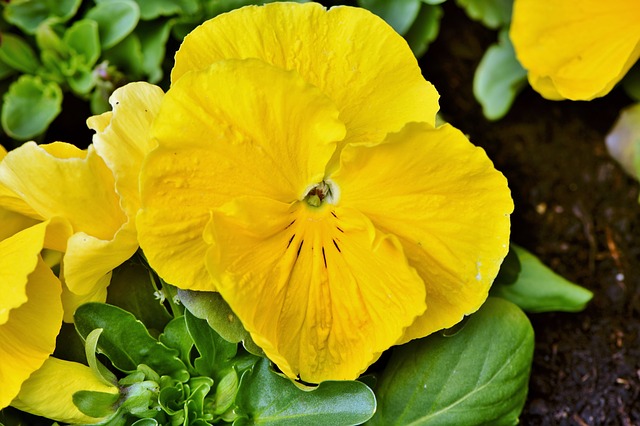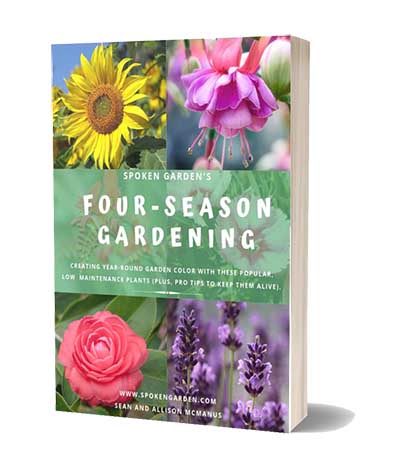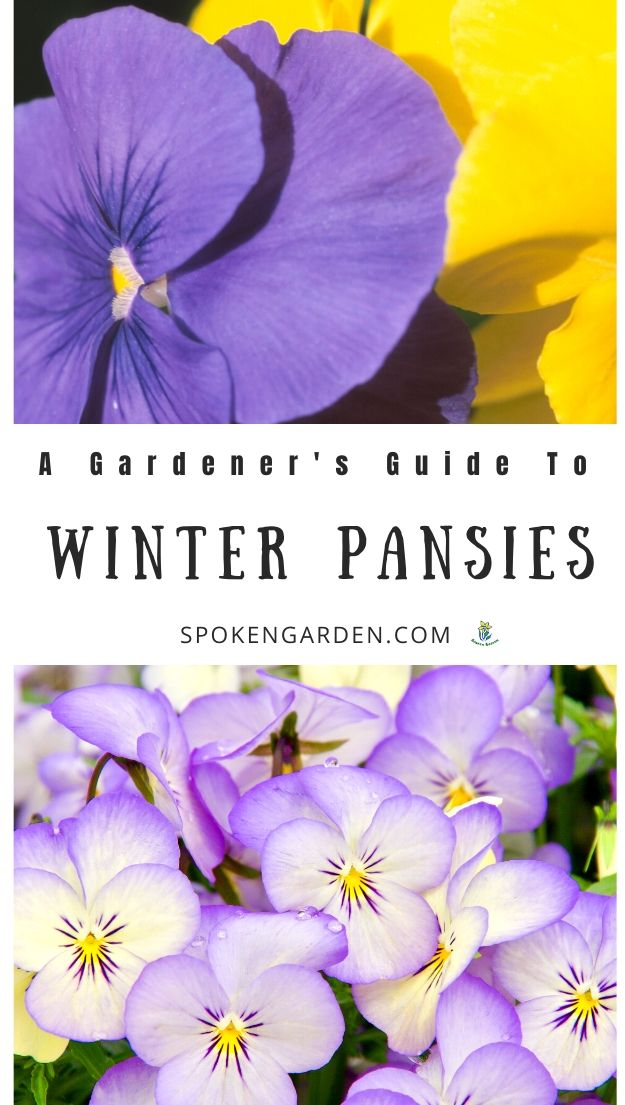Learn all about Winter Pansies in this gardener’s guide of these beautiful perennials, including plant care, companion plants, medicinal uses, and more.

Winter pansies are a double-threat, possibly even a triple-threat. They are beautiful to look at, add color to your fall, winter, AND spring garden, and they are edible.
A larger relative of violas and violets, these beautiful garden flowers could bloom almost year-round in certain climates, if you know the proper plant care.
In this winter pansy plant profile, you’ll learn about the unique characteristics of this plant as well as basic plant care and companion plants for your landscape.
If you’re already lucky enough to have these perennials in your garden but you are unsure how to best care for them, this post will teach you the skills you’ll need. Or, if you are new to gardening and want to add these to your landscape but you’re scared you might kill them with your black thumb, don’t worry.
This post will give you the confidence you need to grow and care for them on your own.
Quick Plant Care Facts
| Sun Exposure | Full sun or partial shade. |
| Water Needs | Needs moderate to regular water. |
| Soil Needs | Pansies prefer woodland forest soils with high organic matter and well-draining soil. It can also grow in rock gardens, but still needs well-draining soil. |
| Cold-Hardiness Zones | USDA hardiness zones 4 to 10. |
| Bloom Time | Winter and spring bloomers in mild-winter areas and spring into summer bloomers in colder climates. |
| Flower Colors | White, Blue, Maroon, Black, Red, Rose, Yellow, apricot, purple and then in bi-and tri-color mixed flowers with dark lower petal blotches and some can resemble faces. |
| Mature Height/Width | Shrub type strains can grow anywhere from 6 inches to 10 inches high and from 9 inches to 12 or more inches wide. |
| Plant Spacing | Plant on 8-inch to 12-inch centers so plants grow into adjacent plants to give good coverage for weed control. If weeds aren't an issue then 1-foot centers (or larger) are fine. Mass plantings can be 6 inches to 9 inches centers. |
Become a Plant Profile Club member here, if you want more winter pansies plant care information than this!
[convertkit form=1655951]
Oh, and if you want to plant bulbs this spring for beautiful summer flowers, check out How to Plant Your Garden Bulbs (eBook)
Winter Pansies: Why You Should Love Them
Pansies are amazing plants because they are always in bloom somewhere in the world.
We love pansies for so many reasons but mainly because they prefer cooler temperatures and can actually survive cold temperatures in several zones which makes them perfect for your fall and winter gardens.
If you like color (and who doesn’t), these plants are for you. Their flowers bloom in striking hues of yellow, orange, red, white, purple, or even blue.
An interesting fact is that their flowers may bloom as one single color, or have a dark, central “face” with variegated black lines radiating out from their centers
Also, pansies always have five petals, just like their viola relatives. (By the way, later on in this post, we’ll discuss the similarities and differences between pansies, violas, and violets).
Furthermore, pansies are perfect for flower borders, cottage gardens, hanging baskets, or containers. Really, you can plant them just about anywhere.
As you can see, this plant is a great addition to anyone’s garden for so many reasons.
Pansies: History and Uses
As you begin your journey to understand more about pansy care, a good place to start is to first learn about their family group, their history, and their uses. Read on below for more!
Violaceae Family
Pansies are in the Violaceae family. Also known as the Violet family, this family group has over 800 species of herbaceous perennial, herbs, shrubs, and trees throughout the world.
The Violet family features some of the most popular flowers in the world including quite a few you have probably heard of before. You may have even confused their names or their identities before (looking at you, violas and pansies), but as we said above, we’ll clear up those differences later in the post.
Violet family members are valued for a range of uses, including:
- Salads
- Syrups
- Blood purification
- Bruises
- Ulcers
- Cancer
- Ornamental gardens
- Garnishes
- Herbal teas
- Other medicinal uses
Other members of the Violaceae family include violas, violets, wild violets, eastern green violet, spade flower, and many more.
You can find more of winter panies care needs, when it flowers, its uses, and more by becoming a Plant Profile Club member.
History of Pansies (in Brief)
Pansies evolved from several species within the Viola genus into the hybrid usually known as Viola x wittrockiana. This is the large-flowered garden pansy we know and love today.
Their family’s story begins in the cool, temperate regions of Europe. As early as the 4th Century in Greece, a type of viola (or wild pansy) was foraged and used for its medicinal properties.
Fast forward a few centuries to the early 1800s in England, and the modern garden pansy was born. A gardener began breeding several violas together and succeeded in creating this “pansy” that had larger flowers and a dark-colored “face.” He called it ‘Medora.’
Their popularity exploded.
Continuing to be grown abundantly until the mid-1800s, pansies were beloved in English gardens, eventually “crossing the pond” to North America as most flower origin stories do.
Pansy breeding continued throughout the 1900s in many countries.
Today, pansies are a garden staple due to their tolerance for cooler weather. They are enjoyed around the world in fall, winter, and spring gardens.
Uses for Pansies (or Violas)
As we stated in the history section above, pansies were used as long ago as the 4th Century in Ancient Greece for their medicinal properties.
More recently, people have used the edible parts of the flowers and leaves for various reasons.
Examples of edible or medicinal uses include:
- Syrup
- Flavored honey
- In salads
- As herbal tea
- As a garnish in many dishes
- As a dye
- For various skin conditions
Pansy Care
Now that you’ve learned a bit of background information, keep scrolling to learn more about planting steps, companion plants, and differences between pansies, violas, and violets.
You can find more of winter pansies care needs, when it flowers, its uses, and more by becoming a Plant Profile Club member.
Differences Between Pansies and Violas (and Violets)
Pansies and violas are commonly mistaken for one another. Violets too. In fact, all of their names are quite often used interchangeably.
All three flowers are perennials but are usually treated as annuals. And they all have five petals on their flowers.
Both violas and pansies can take more full sun than violets can. Violets prefer more shade and love living in woodland rock gardens.
One of the biggest differences between violas and pansies are in their sizes. Violas are smaller than pansies and it is easiest to see when you have two flowers side-by-side.
Plus, another way to tell them apart is pansies have four petals facing up and one petal pointing down toward the ground while violas have three petals facing up and two petals facing down.
What Month Do You Plant Winter Pansies?
Pansies need certain temperatures in order to thrive and bloom in the winter months for you to enjoy.
In general, they should be planted in the ground before your soil temperatures reach 45°, so ideally, sometime in the fall.
Depending on your zone, this could mean anytime between mid-September (zone 6) through November 1st (zone 8).
Using a good soil thermometer, like this one, could help you to determine the exact soil temp and monitor it for optimal planting time.
How Long Do Winter Pansies Last?
In ideal conditions, pansies can bloom upwards of 5-7 months. That is a huge bang for your buck.
When planted in the fall, pansies can begin blooming in September and bloom all the way until April or even May!
Again, that is assuming you have ideal growing conditions.
Winter Pansy Colors
Winter pansies come in a range of beautiful colors. Perfect for any garden during any season (depending on your zone of course).
Whether you grow your pansies from seed or by plants at a local garden center, you’ll find pansies in the following colors:
- Yellow
- Orange
- Red
- White
- Purple
- Blue
- Maroon
- Violet
- Gold
- Black
Winter Pansy Companion Plants
Pansies could potentially bloom for many seasons, therefore, they could have a lot of options for friends.
In the winter season, you will be a bit more limited to foliage or other winter bloomers that grow in similar conditions.
However, a lot of the suggesting companions are edible, so BONUS.
You really cannot go wrong with a companion for your pansies. It simply boils down to your individual preference, color choice, and sunlight needs.
Companion plants to consider:
- Violas, like Johnny Jump Ups
- Other Pansies
- Dianthus
- Ornamental Kale: Lacinato, Red Russian
- Ornamental Cabbage
- Dusty Miller
- Swiss Chard
- Red Giant Mustard
You can find more of winter pansies care needs, when it flowers, its uses, and more by becoming a Plant Profile Club member.
Winter Pansies in Containers
Pansies make a great addition to your winter containers.
With their variety of color and length of blooms, they can enhance your landscape with color and interest. Most of our pansies are in hanging baskets by themselves for pops of color around our yard.
However, using any of the companion plants from the previous list, such as ornamental kales, ornamental cabbages, Dusty Miller, or other members of the Violaceae family, you can create amazing winter containers.
Another fun option is to plant some of your spring-blooming daffodil, tulip, or crocus bulbs underneath the pansies in your container. Then, get ready for a beautiful spring explosion of color from your pansies (which should bloom again and all your spring-blooming bulbs.
Winter Flower Care Reading Material
If you’re looking for further educational resources about all types of bulbs and other plants, these books below are great educational references!
The first book is one of our new eBooks which we’re so excited to show you! The other book below that can be found on Amazon at the links below.
Four-Season Gardening
If you want to create a four-season garden featuring specific, beautiful plants that bloom during specific seasons, look no further than our new book!
In Four-Season Gardening, we’ll teach you plant care tips for 15 seasonal plants and seasonal gardening tricks that could be the difference between a thriving garden and a ho-hum garden. Check it out!

American Horticultural Society Encyclopedia of Plants and Flowers
This is a great reference guide for tons of different perennial and annual plants from the American Horticultural Society.

Winter Pansy Conclusion
As you’ve read above, pansies will enhance your winter landscape in so many ways. With all the beautiful colors available and length of blooming season, you really cannot go wrong.
Planting pansies in the fall season and being mindful of their growth needs (and your soil temperature), your pansies should continue to bloom well into the spring season.
Now we want to hear from you!
What other questions do you have about winter pansies that we didn’t answer above? Let us know by leaving a quick comment below. Thanks!
Want to learn about other plants in your garden? Check out some of our previous plant profiles:
- Daffodils: A Gardener’s Guide and Plant Profile
- Crocosmia: A Gardener’s Guide and Plant Profile
- Primroses: A Gardener’s Guide and Plant Profile
- Tulips: A Gardener’s Guide and Plant Profile
- Grape Hyacinth: A Gardener’s Guide and Plant Profile
- Sunflowers: A Gardener’s Guide and Plant Profile
See you in the garden!
~ Sean and Allison
P.S. Find us on Pinterest, Twitter, Facebook, and Instagram so you don’t miss a thing!
Pansy References:
- American Violet Society
- Success With Pansies in the Winter Landscape – University of Georgia Extension
- Winter Pansies – HGTV
Spokengarden.com is a participant in the Amazon Services LLC Associates Program, an affiliate advertising program designed to provide a means for sites to earn advertising fees by advertising and linking to Amazon.com

Learn all about Winter Pansies in this gardener’s guide of these beautiful perennials, including plant care, companion plants, medicinal uses, and more.


